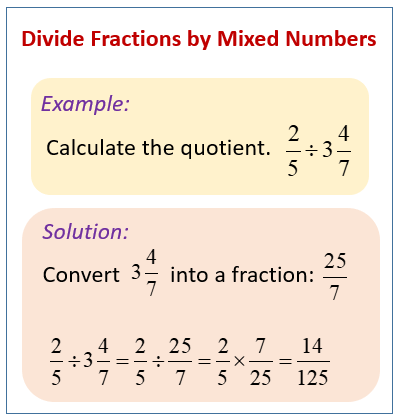Prelude to Fraction Division
Fractions are often encountered in our daily lives, whether in cooking recipes, measurements, or mathematical equations. As we delve deeper, we come across scenarios where dividing fractions with mixed numbers and whole numbers becomes essential. Mixed numbers, comprising both a whole number and a fraction, often create a stumbling block for students. This article aims to unravel the mysteries of fraction division, empowering you with the knowledge and skills to confidently tackle these computations.

Image: www.onlinemathlearning.com
Understanding Fraction Division
Fraction division is the process of finding a fraction that, when multiplied by the dividend, results in the divisor. Consider this analogy: if a pizza (dividend) is divided among a certain number of people (divisor), each person receives a specific fraction of the pizza. The fraction we are solving for represents the amount of pizza each person gets.
Step-by-Step Procedure for Dividing Mixed Numbers
Now, let’s walk through the detailed steps involved in dividing fractions with mixed numbers:
Step 1: Convert Mixed Numbers to Improper Fractions
Convert both the mixed numbers into improper fractions. An improper fraction has a numerator greater than or equal to its denominator. To do this, multiply the whole number by the denominator and add the numerator. The resulting number becomes the new numerator, and the denominator remains unchanged.
Example:
Convert 2 1/2 to improper fraction: (2 * 2) + 1 / 2 = 5 / 2
Step 2: Invert the Divisor
Invert the divisor (the fraction on the right-hand side of the division sign) by switching its numerator and denominator. This step transforms the division into multiplication.
Example:
If the divisor is 3/4, invert it to 4/3.
Step 3: Multiply the Fractions
Multiply the dividend (the fraction on the left-hand side of the division sign) by the inverted divisor. The product is the result of the division.
Example:
If the dividend is 5/2 and the inverted divisor is 4/3, multiply them:
(5/2) (4/3) = (5 4) / (2 * 3) = 20/6
Step 4: Simplify the Result
If possible, simplify the result by reducing it to its lowest terms. To do this, find the greatest common factor (GCF) of the numerator and denominator and divide both by the GCF.
Example:
Simplify 20/6 by dividing both numerator and denominator by 2:
20/6 = (20 ÷ 2) / (6 ÷ 2) = 10/3
Therefore, the final result is 10/3, which is an improper fraction.
Tips for Success
Here are some tried-and-tested strategies to enhance your understanding of fraction division:

Image: www.blendspace.com
1. Master the Concept of Unit Fraction
Unit fractions (fractions with a numerator of 1) are building blocks for other fractions. Familiarize yourself with unit fractions and their relationship with whole numbers.
2. Practice with Manipulatives
Hands-on learning with manipulatives like fraction circles or blocks can greatly enhance your comprehension.
3. Relate Fractions to Real-Life Scenarios
Connect the abstract concept of fractions to everyday situations, such as sharing food or measuring ingredients.
Frequently Asked Questions (FAQs)
Q: Can I divide a whole number by a fraction?
A: Yes, you can divide a whole number by a fraction by writing it as an improper fraction. For instance, 5 ÷ 1/2 is the same as 5/1 ÷ 1/2.
Q: Do I always have to simplify my answer?
A: Yes, it is good practice to simplify your result to its lowest terms to ensure accuracy and avoid incorrect interpretations.
Dividing Fractions With Mixed Numbers And Whole Numbers
Call to Action
Dividing fractions with mixed numbers and whole numbers can be a formidable task. By equipping yourself with the knowledge and techniques outlined in this guide, you can conquer this challenge confidently. Remember, practice and persistence are key. If you have any further questions or need additional support, do not hesitate to reach out to your teacher, tutor, or a knowledgeable friend. Embrace the learning journey and unlock the secrets of fraction division!


/GettyImages-1303637-two-way-mirror-57126b585f9b588cc2ed8a7b-5b8ef296c9e77c0050809a9a.jpg?w=740&resize=740,414&ssl=1)


